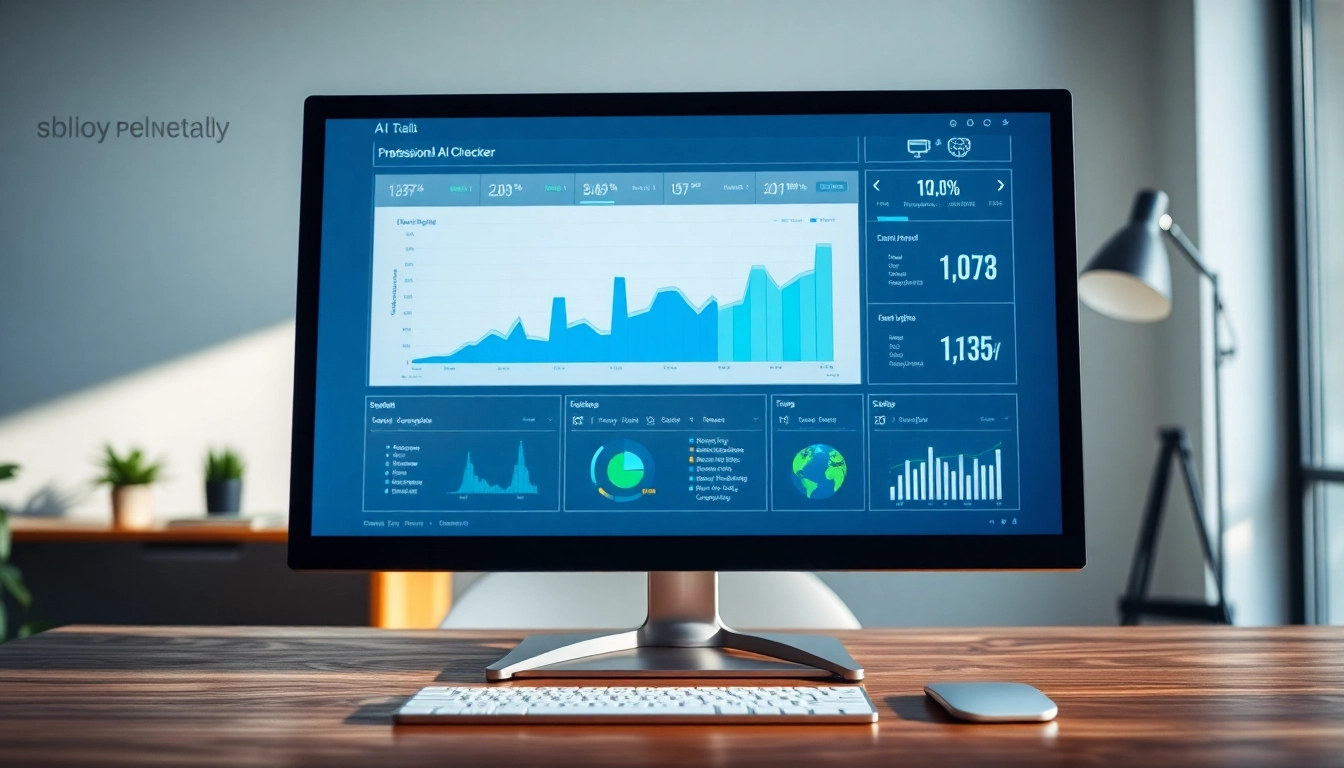
Mastering Text Authenticity: The Role of AI Checker Tools in Quality Assurance
Understanding AI Checkers
In an era where artificial intelligence shapes various aspects of life, the advent of AI checkers has become paramount for authenticity verification. But, what exactly is an AI checker, and how can it benefit students, educators, content creators, and businesses alike? AI checkers serve as powerful tools designed to analyze text and assess whether it is generated by artificial intelligence or penned by a human. This process of detection is critical, given the increasing reliance on AI-generated content across industries.
What is an AI Checker?
An AI checker is a sophisticated tool that employs algorithms and machine learning techniques to detect AI-generated content. These tools evaluate writing styles, syntax patterns, and other linguistic features to determine whether the text in question originates from a human or an AI model. The significance of AI checkers extends into numerous domains, including education, journalism, and corporate communications, where the integrity of content is essential.
How AI Checkers Work
The mechanics behind AI checkers involve intricate algorithms that deconstruct text into various components. The primary objectives of these tools include:
- Pattern Recognition: AI checkers analyze sentence structures and word usage to identify characteristics of AI writing. For instance, many AI-generated texts tend to have a uniform tone or may use complex vocabulary excessively.
- Statistical Analysis: By using large datasets of known AI-generated and human-written texts, these tools can apply statistical models to compare the features of the input text with those in their database.
- Machine Learning: Most AI checkers leverage machine learning to improve their accuracy over time. They continuously learn from user feedback and evolve their algorithms to provide more reliable results.
Benefits of Using an AI Checker
The integration of AI checkers into various workflows introduces several advantages:
- Content Authenticity: Ensuring the originality of content is critical in academic settings and for publishing. AI checkers help maintain credibility by preventing the unintentional submission of AI-generated content as one’s work.
- Plagiarism Prevention: Many AI checkers double as plagiarism detectors, offering a comprehensive solution for content verification.
- Time Efficiency: Automated processes of AI checkers save time for users who need to analyze multiple documents quickly without compromising quality.
- Enhanced Learning Tools: Students can utilize AI checkers to refine their writing techniques by understanding the differences between AI-generated texts and their human counterparts.
Key Features to Look for in an AI Checker
When choosing an AI checker, it’s vital to consider various features that enhance usability and accuracy. Here are the most crucial aspects:
Accuracy and Reliability Metrics
The cornerstone of any effective AI checker is its accuracy. Users should look for tools that provide reliable metrics on how well they detect AI-generated content. Metrics such as:
- False Positive Rates: A good AI checker should have low false-positive rates, indicating it rarely misclassifies human writing as AI-generated.
- True Positive Rates: The ability to correctly identify AI-generated content is crucial. High true positive rates enhance the tool’s credibility.
- User Feedback: Reviews and testimonials from other users can provide insight into the tool’s real-world effectiveness.
User-Friendly Interface
An intuitive interface can significantly impact user experience. Here are elements that contribute to usability:
- Simple Navigation: Checkers should allow users to easily upload documents and access results quickly.
- Clear Reporting: The results should be presented in a comprehensible manner, highlighting crucial metrics and suggested improvements.
- Multi-Platform Compatibility: Compatibility across various devices (desktop, mobile) enhances user flexibility.
Integration with Other Tools
For many professionals, the ability of an AI checker to integrate with other software can streamline processes. Checkers that offer:
- API Access: Allowing developers to embed AI checking capabilities into their applications increases versatility.
- Cloud Storage Options: Facilitating easy access and storage of previously analyzed texts is another plus.
- Output Formats: Users may benefit from having results exported in different formats for reports or presentations.
Comparison of Popular AI Checkers
The market for AI checkers has grown significantly, with several tools vying for attention. Here, we’ll profile some of the most popular options available today, focusing on their strengths, weaknesses, and overall performance.
Analysis of Top Competitors
Prominent AI checkers include:
- ZeroGPT: Noted for its multi-stage methodology which analyzes writing style. Reliable for detecting AI-generated content from various models.
- QuillBot’s AI Detector: Famous for its free-to-use interface that identifies texts produced by key AI platforms, including ChatGPT and GPT-4.
- GPTZero: Praised for its widespread media coverage and the ability to analyze large volumes of content up to 50,000 characters.
Strengths and Weaknesses
Each AI checker has its unique strengths and drawbacks:
- Strengths:
- Robust detection capabilities.
- User-friendly interfaces.
- Fast processing times.
- Weaknesses:
- Some may have higher false positive rates.
- Limited access to integrations and features in free versions.
- Performance can vary based on text complexity.
Pricing and Accessibility
Understanding the pricing structures helps users select the right tool for their budget while ensuring it offers value. Most AI checkers operate on a freemium model, where basic features are available for free, with advanced capabilities requiring a subscription. Here’s a general breakdown:
- Free Tier: Basic functionality without charge.
- Monthly Subscriptions: Ranging from $10 to $30, usually providing more extensive features.
- Enterprise Plans: Typically pricing varies based on the organization’s needs, offering customized solutions.
Best Practices for Using AI Checkers
To maximize the effectiveness of AI checkers, users should follow some best practices:
Optimizing Text for Analysis
Preparing text adequately can influence the results of the AI checker. Key tips include:
- Maintain Consistency: Ensure the writing style remains uniform throughout the text to avoid unnecessary alerts.
- Use Clear Language: Avoid overly complex structures that may confuse detection algorithms.
- Limit Excessive AI Usage: If the text includes direct AI-generated segments, ensure there is a clear indication of this to prevent misclassification.
Interpreting Results Effectively
Understanding the output of an AI checker can be challenging at times. Consider the following:
- Review Recommendations: The checker’s feedback often provides suggestions for improving human-like writing quality.
- Cross-Verification: To validate results, check against multiple AI detectors if possible for consistency.
- Document Progress: Maintaining logs of previously analyzed texts can help monitor improvement trends over time.
Common Misconceptions
Several misconceptions about AI checkers can mislead potential users:
- AI Checkers Can Replace Human Review: While these tools are helpful, they’re not a substitute for human oversight in critical scenarios.
- All AI Checkers are the Same: Each has unique algorithms and methods; therefore, users should research to find the best fit for their needs.
- The Free Versions Are Sufficient: Although useful, premium plans often provide advanced features that enhance detections and overall user experience.
The Future of AI Checker Tools
As technology continues to advance, the landscape of AI checkers is expected to evolve significantly. Here are some trends to watch:
Emerging Technologies in AI Detection
Anticipated innovations include:
- Enhanced Algorithms: Future checkers will likely implement more sophisticated algorithms that better differentiate between human and AI-generated text.
- Broader Language Support: Emerging AI checkers are increasingly anticipated to cater to multilingual texts, accommodating diverse user bases.
- Integration of NLP Features: Natural Language Processing will increasingly feature in AI checkers, improving accuracy and capabilities in understanding context.
Potential Industry Impact
The rising importance of AI checkers will have far-reaching implications including:
- In Education: Educational institutions may adopt AI checkers as standard practice to promote academic integrity.
- For Publishers: Content editors and publishers may rely on AI detection before content goes live, reinforcing standards of originality.
- Impacts on AI Developers: AI tool creators might respond to the challenges posed by these checkers to develop inherently more human-like writing models.
Advice for Users
As AI checker technology advances, users should take proactive steps:
- Stay Updated: Regularly review updates from AI checkers as they refine their features and capabilities.
- Engage with Communities: Join forums or groups where users share insights and experiences related to AI checkers.
- Continuously Improve Writing Skills: Use feedback from AI checkers as a learning opportunity to enhance writing quality over time.
